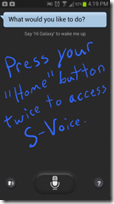Here they are in a nutshell.
- Use catchy headlines instead of course titles
- Create teasers
- Write a compelling lead
- Quote from engaging sources
- Close with a kicker
 On most Android devices, there is a small microphone button on the keyboard. If you tap this button when writing an e-mail, you can read the information from your media, and it will be transcribed into text for you. Send the e-mail to yourself, and copy it into a Word Document, a page in your online course, etc.!
On most Android devices, there is a small microphone button on the keyboard. If you tap this button when writing an e-mail, you can read the information from your media, and it will be transcribed into text for you. Send the e-mail to yourself, and copy it into a Word Document, a page in your online course, etc.!  On Samsung’s Android devices, you have “S-Voice”, which will do much the same thing. Create a new e-mail message, and in the body of the message, quickly press the “Home” button on your device twice. This will launch S-Voice. Once S-Voice has loaded, you can tap the large button to pause or re-start your transcription at any time.
On Samsung’s Android devices, you have “S-Voice”, which will do much the same thing. Create a new e-mail message, and in the body of the message, quickly press the “Home” button on your device twice. This will launch S-Voice. Once S-Voice has loaded, you can tap the large button to pause or re-start your transcription at any time.